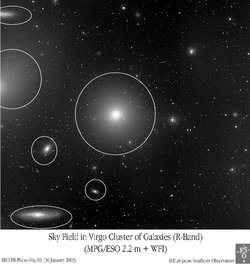Virgo cluster
|
|

The Virgo cluster is a cluster of galaxies, approximately 15 to 22 Mpc distant, comprising approximately 1300 (and possibly up to 2000) member galaxies. The cluster forms the heart of the larger Local supercluster, of which the Local Group is an outlying member.
The cluster was discovered by Charles Messier in 1781, who charted many of its prominent member galaxies, including the giant M87 galaxy.
The cluster subtends a maximum arc of approximately 8 degrees centered in the constellation Virgo. Many of the member galaxies of the cluster are visible with a small telescope. The distance to the cluster is still an open question, with current best guesses, based on Cepheids using the Hubble Space Telescope, yielding an average of approximately 20 Mpc [1] (http://nedwww.ipac.caltech.edu/level5/Binggeli/Bin4.html).
The cluster is a fairly heterogenous mixture of spirals and ellipticals. It is currently believed that the spirals of the cluster are distributed in a cigar-shaped prolate filament, approximately 4 times as long as wide, stretching along the line of sight from the Milky Way and connecting on its back end to the W cloud [2] (http://nedwww.ipac.caltech.edu./cgi-bin/nph-ex_refcode?refcode=1993ApJ...412L..13F). The ellipticals are concentrated much more than the spirals.
The cluster is an aggregrate of at least three separate subclumps centered on the galaxies M87, M86, and M49. Of the three subclumps, the one centered on M87 is the dominant one, with a mass of approximately 1014 solar masses, which is approximately an order of magnitude larger than other the other two subclumps [3] (http://nedwww.ipac.caltech.edu/level5/Binggeli/frames.html).
The large mass of the cluster is indicated by the high peculiar velocities of many of its galaxies, sometimes as high as 1,600 km/s with respect to the cluster's center.
The Virgo cluster lies within the Local supercluster, and its gravitational effects slow down the nearby galaxies. The large mass of the cluster has the effect of slowing down the recession of the Local Group from the cluster by approximately ten percent.
More info:
- University of California site (http://cosmology.berkeley.edu/Education/superclusters.html) on Virgo cluster.
- California Institute of Technology site (http://nedwww.ipac.caltech.edu/level5/Binggeli/Bin4.html) on Virgo cluster.
- Heron Island Proceedings (http://msowww.anu.edu.au/~heron/Tonry/tonry_p2.html)
- Chandra X-Ray Observatory: The Virgo Cluster (http://chandra.harvard.edu/xray_sources/virgo/)
- The Virgo Cluster of Galaxies (http://www.seds.org/messier/more/virgo.html), SEDS Messier pagesca:C˙mul Virgo
de:Virgo-Galaxienhaufen fr:Amas de la Vierge it:Ammasso della Vergine nl:Virgocluster
